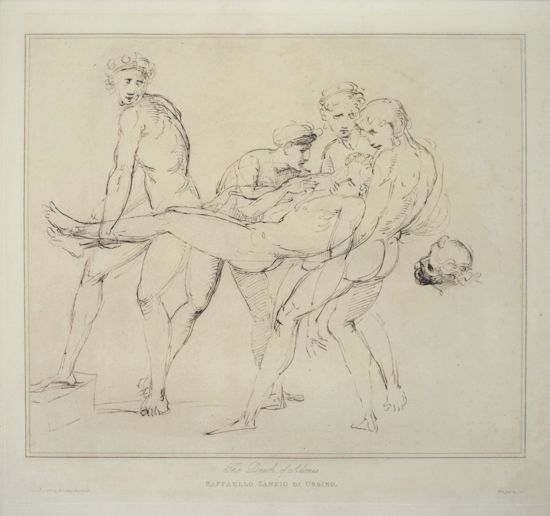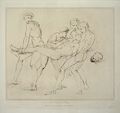| Title: |
The Death of Adonis |
| Engraver: |
Long, William (British, active London c. 1816 - 1855) |
| Designer: |
Raphael 'Raffaello Santi' (Urbino, 1483 - Rome, 1520) |
| Date: |
1818 (1823 Edition) |
| Medium: |
Original Etching with Plate Tone |
| Publisher: |
Taylor and Hessey, 13, Waterloo Place, and 93, Fleet-Street, London |
| Printer: |
J. Mc Creery, Tooks-Court, Chancery-Lane, London |
| Source: |
The Italian School of Design (Compiled by William Young Ottley) |
| Note: |
William Long: A talented early 19th century British painter and printmaker, William Long was admitted as a probationer and registered as a student at the Royal Academy Schools in 1816. He was awarded a silver medal for an original sketch of a lady and child at the Society of Arts in 1814-1815, and continued to exhibit at the Royal Academy from 1821 – 1855. William Long later worked with William Young Ottley engraving and etching many plates for Ottley's Italian art publications, including The Italian School of Design set. Some of his best work was created at this time. "The Death of Adonis", is an original soft ground etching based upon a drawing by Raphael. It is one of many original soft ground etchings William long contributed to the portfolio published by William Young Ottley entitled "The Italian School of Design". The Royal Academy, London includes an impression of William Young’s soft ground etching entitled "The Death of Adonis" after a drawing attributed to Raffaello Sanzio in its collection, Object number 17/4063. |
| |
Raphael (Raffaello Santi or Raffaello Sanzio di Urbino): Although he lived only thirty-seven years Raphael stands at the summit of High Renaissance art. He entered the workshop of Perugino in Perugia some time before 1499 and remained there until 1504. He then worked for four years in Florence before moving permanently to Rome. There Raphael was commissioned by Pope Julius II to decorate the papal apartments. Such famous frescoes as the School of Athens were completed by 1511. In 1513, Leo X became
Pope and appointed Raphael his Prefect of Antiquities. Raphael's duties now widened to include architecture, archaeology and tapestry design. Upon his early death in 1520, Raphael was buried with the highest honors in the Pantheon. Raphael is also listed as (Raffaello Santi & Raffaello Sanzio di Urbino). |
| |
William Young Ottley: Born in Thatcham, England, 1771, William Ottley will forever be remembered both as an artist and as an art scholar. Having studied art under Cuitt and then in the Schools of the Royal Academy, London, William Ottley went to Italy in 1791 where he resided for ten years, researching and collecting works of Renaissance art. During his life Ottley became the greatest authority on the art of the Italian Renaissance and, upon returning to London, published a number of portfolios and books upon this subject. Apart from the biographical and scholarly information Ottley unearthed, the most valuable product of his researches was the meticulously detailed and artistic etchings and engravings he published. Either in their large folio size or in the smaller miniatures, these outstanding masterpieces of original printmaking have been admired for almost two centuries. Later in his life (1833), William Young Ottley was appointed to the prestigious post of Keeper of the Prints for the British Museum. |
| |
The literary contributions of William Young Ottley included such works as, "The Italian School Of Design" (1808-1823), "An Inquiry Into The Origin And Early History of Engraving, Upon copper and in Wood, With An Account of Engravers And Their Works, From The Invention of Chalcography By Maso Finiguerra, To The Time of Marc' Antonio Raimondi", 2 volumes, (1816), "Engravings Of The Most Noble The Marquis Of Stafford's Collection Of Pictures, In London, Arranged According To Schools, And In Chronological Order, With Remarks On Each Picture,", 3 vols. (1818), "A Series of Plates, Engraved After The Paintings And Sculptures Of The Most Eminent Masters Of The Early Florentine School"; (1826), "A Descriptive Catalogue of The Pictures In The National Gallery" (1826), "The Original and Early History of Engraving", 2 volumes (1826), and "A Collection of One Hundred and Twenty-Nine Fac-Similes of Scarce and Curious Prints, By the Early Masters of the Italian, German, and Flemish Schools" (1828). Then in (1831), Ottley authored, "Notices of Engravers, and Their Works: Being The Commencement of a New Dictionary, Which it is Not Intended Continue, Containing Some Account of Upwards of Three Hundred Masters...", and "An Enquiry Concerning the Invention of Printing" was published posthumously (1863). The Death of Adonis by William Long etched after a drawing by Raphael (Raffaello Santi) hails from William Young Ottley's portfolio entitled, The Italian School of Design published by Taylor and Hessey, 13, Waterloo Place, and 93, Fleet-Street, London in 1823. |
| |
Of all Ottley's works of art, The Italian School of Design stands as his paramount achievement. Concentrating upon the drawings in his own collection by such masters of the High Renaissance as Raphaele, Correggio, the Carraccis, Salvator Rosa and other early Italian artists, William Ottley began work on his major opus as early as 1808, publishing etchings and engravings in monthly parts and concluding the work in 1823. Altogether the completed portfolio contained eighty-four plates, engraved by such eminent artists as Luigi Schiavonetti (1765 - 1810), Thomas Vivares (1735 - 1821), William Long (act. early 19th c.), Giovanni Vendramini (1769 - 1839), J. Perry, John Romney (1786 - 1863), Ignace Joseph de Claussen (1769 95 - 1844), William Young Ottley (1771 - 1836), Frederick Christian Lewis (1779 - 1856), and his younger brother, George Lewis (1782 - 1871), and others. The utmost care was taken with each engraved work, with the artists often venturing into the most complex mediums, such as stippling, soft-ground and aquatint. William Young Ottley himself supervised the progress of each etching. These original etchings revolutionized British trends in art and had a profound impact upon the art of the Pre-Raphaelites in the later nineteenth century. An original etching, The Death of Adonis was etched in 1818 by William Long for William Young Ottley's The Italian School of Design. The Royal Academy of Arts Museum, London includes an impression of The Death of Adonis from the 1823 “The Italian School of Design” edition in its collection (Object number:17/4063). |
| |
William Young Ottley contributed at least ten original etchings to his "The Italian School of Design". He either worked on the plates along with another printmaker or would etch the entire plate himself. They were all based upon the drawings in his collection attributed to Michelangelo, Niccola Pisano, Giunta Pisano, Giovanni Cimabue, Giotto di Bondone, Niccolo di Betto Bardi ‘Donatello’, Leonardo da Vinci, Raffaello Sanzio 'Raphael', Francesco Mazzuoli and others. William Long also contributed many etchings to this portfolio, most of them attributed to drawings after Raffaello Sanzio. These include; #31. "Three figures in conversation" after Michelangiolo, #40. "Head-piece, A group of Women and Children from the Fresco of Raffaelle, representing 'The story of Heliodorus,' in the Vatican" after Raffaelle, #42. "The Nativity" after Raffaelle, #45. "A Youth at His Devotions" after Raffaelle, #46. "A music party (a group of three figures)" after Raffaelle, #51. "Study for the Figure of Diogenes, in the School of Athens" after Raffaelle, #56. "Study for the compartment representing 'God appearing to Moses in the burning bush,' painted in one of the ceilings of the Vatican" after Raffaelle, #57. "The Adoration of the Shepherds" after Raffaelle, #58. "Study for 'the figure of Adam,' in the celebrated print of 'Adam and Eve" by Marc Antonio" after Raffaelle, #59. "The Death of Adonis" after Raffaelle, #60. "Sea Nymphs and Tritons sporting in the water" after Raffaelle, and #62."A female figure, standing" after Raffaelle. |
| Size: |
13 X 14 1/2 (Sizes in inches are approximate,
height preceding width of plate-mark or image.) |
| |
UnMatted |
| Buy Now |
Price: $325.00 US |
| Condition: |
Printed upon 'Whatman' watermarked paper and with wide, full margins as created by William Long in 1818 for William Young Ottley's portfolio entitled, The Italian School of Design published by Taylor and Hessey, 13, Waterloo Place, and 93, Fleet-Street, London in 1823. Inscribed, "The Death of Adonis. Raffaello Sanzio di Urbino. Pub.d May 1. 1818. by W. Y. Ottley. Kensington. W. L fecit aq for.". Bearing all the fine lines and tonal values of a very early impression and in excellent condition throughout. This famous engraving represents a prime, original example of both the art of William Long and of Ottley's, Italian School of Design. |
| Important Information: |
The artist biographies, research and or information pertaining to all the original works of art posted on our pages has been written and designed by Greg & Connie Peters exclusively for our site, (www.artoftheprint.com). Please visit us regularly to view the latest artworks offered for sale. We will soon be posting an update of our most recent research and include the biographical and historical information pertaining to our next collection of original works of art created by artists throughout the centuries. We hope you found the information you were looking for and that it has been beneficial.
Our Gallery, (Art of the Print / www.artoftheprint.com) guarantees the authenticity of every work of art we sell 100%. Full documentation and certification is provided. We offer a wide selection of international fine art dating from the early Renaissance to the contemporary art period. |

















![]()
![]() or
phone Greg & Connie (905) 957-6666
or
phone Greg & Connie (905) 957-6666